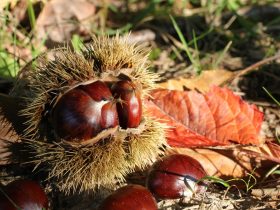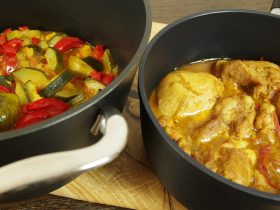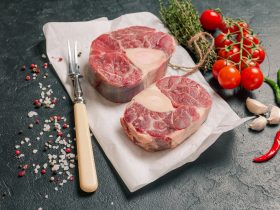Squirrel, while unusual to consume, is often spoken of as similar to that of rabbit meat. With a softer and less sharp taste, squirrel makes an excellent replacement for any primary ingredient involved in a game-meat dish.
As squirrels have a more delicate and softer texture than that of rabbit meat, proper care must be taken when butchering the squirrel, especially because of the fact that squirrel has very little available meat on its body1.
Squirrel meat tastes like rabbit – it presents much of the same gamey notes and earthy flavors. While rabbit is often compared to chicken breast meat, it would be far more accurate to say that squirrel itself tastes similar to chicken thighs, owing to its weaker and more delicate flavor2.’
How Much Meat Does One Squirrel Have?
Squirrels, being relatively small arboreal creatures, have very little edible meat present on their body. Connective tissues such as silver skin and cartilage, while still technically edible, are usually found to be unpleasant to eat and difficult to cook.
Because of this, it is found that the average squirrel will yield only an approximate 0.435 pounds of meat, so long as it is butchered with precision and skill.

Because it is somewhat uncommon to butcher squirrels for their meat, one may find it quite difficult to find a butcher experienced enough to maximize the amount of meat cut from the squirrel’s body. If one so desires, they may instead butcher the squirrel themselves.
How is Squirrel Meat Harvested?
As previously mentioned, squirrels are small animals with a moderate amount of connective tissue and as such require precise kitchen tools that are miniscule enough to fit between the squirrel’s bones.
Using a set of kitchen shears, the butcher will remove the ends of your squirrel’s limbs as well as its head. Once these inedible parts are removed, the butcher will utilize a tiny knife to disconnect the skin from the meat beneath. You may request to keep this furry pelt if you so desire.
After skinning, the butcher will disembowel the squirrel with the same knife, though he may save several of the internal organs, as these are edible so long as they are washed clean.
Once this process is complete, the butcher will divide and debone the squirrel according to your requests. As a squirrel has little meat on its body apart from its hind legs, you may ask the butcher to simply debone most of the torso and forelimbs so as to make cooking them easier.
After returning from the butcher, ensure that the meat is either kept in a freezer at temperatures of 32°F or consumed in its entirety immediately. Like all meat, squirrels will expire quite quickly if left unattended on the counter.
How is Squirrel Meat Cooked?
Much like rabbit, squirrel is cooked in a variety of ways and added to a large swathe of dishes as either a main ingredient or a secondary meat. Depending on the area of origin, squirrels may be cooked in savory stews or even simply grilled over an open fire.
The most common dish utilizing squirrel meat as its primary ingredient is referred to as Brunswick stew. Originating from U.S. states such as Virginia, North Carolina and Georgia, Brunswick stew presents a hearty and savory flavor excellent for cold nights.
Consisting of beans, vegetables and either squirrel or rabbit, Brunswick stew was originally intended to be produced from ingredients harvested and hunted by the very same person cooking this stew, providing a self-sufficient experience for the resourceful home chef.
Apart from savory stews, squirrel is also frequently baked into a savory-sweet casserole under low heat, often added to vegetable stock and fresh produce such as carrots and potatoes. Because of the nature of game meat, it is important to ensure that the heat used when baking squirrels is kept relatively low, and that the meat has adequate liquid to absorb within its cooking vessel.
Alternatively, one may simply pan-broil the meat, though this will prove difficult if the butcher has not removed the meat from the bones. Ideally, one can place a small amount of red wine and oil within a preheated cast iron skillet and lay the squirrel haunches against the surface, allowing it to form a brown crust.
Roasting or grilling squirrel is also an excellent way to cook it, though game meat is notoriously low in fat and as such burns and dehydrates quite quickly without outside moisture involved.
Should you choose to roast or grill your squirrel meat, ensure that it is either well-marinated or basted in oil or butter, as this will both provide an excellent flavor to the meat as well as prevent it from drying out.
If dried out, squirrel meat will develop a stringy and chewy texture, of which will be quite unpleasant to consume.
Can Squirrel Meat Go Bad?
Like all meat, squirrels will become unsafe to eat in a very short time if steps are not taken to preserve it in its best possible quality.
If left out at room temperature in a relatively average humidity environment, squirrels will begin to develop bacterial and fungal colonies as quickly as within two hours.
In order to prevent this, keep the squirrel within the refrigerator for up to twenty-four hours or in the freezer for several months.
Keep in mind that, if caught in the wild, the squirrel may have parasites that were already present in the meat prior to butchering, and as such can be unavoidably harmful to eat. It is best to purchase squirrel from a reputable supplier instead of catching it yourself for this very reason.
What Flavors Pair Well with Squirrel Meat?
Because of the subtle yet gamey flavor that squirrel presents, it can pair quite well with a large variety of ingredients and spices. Depending on the particular method of cooking and dish that you wish to cook, any number of herbs or spices may be added to aid the squirrel meat’s flavor.
If you are cooking a savory dish, the herbs that pair best with squirrel are much the same as the ones you would use to season chicken, namely rosemary, thyme and oregano. The earthy flavors of these herbs will complement and help bolster the delicately wild flavor of squirrel meat.
In the spices rack, one may pair squirrel meat with hot and slightly pungent additives, such as cayenne and chili pepper.
It is also an excellent idea to cook the squirrel meat in ingredients high in moisture such as dry red wine or tomato sauce, as these will both prevent the meat from becoming too dry and complement their flavor perfectly.
As an added bonus, it is also possible to fry squirrel meat in bacon fat, which will have the same anti-drying effect as well as add a delicious savory note to the taste.
References
1. Beard, James (28 February 2009). James Beard’s American Cookery. Little, Brown
2. Chef’s Pencil Staff (June 2020) “What Does Rabbit Taste Like?” chefspencil.com https://www.chefspencil.com/what-does-rabbit-taste-like/





Hi, I'm Dom
Dom Eats was started to help other people fall in love with food. While cooking can feel intimidating, it doesn't have to be.